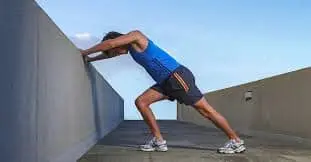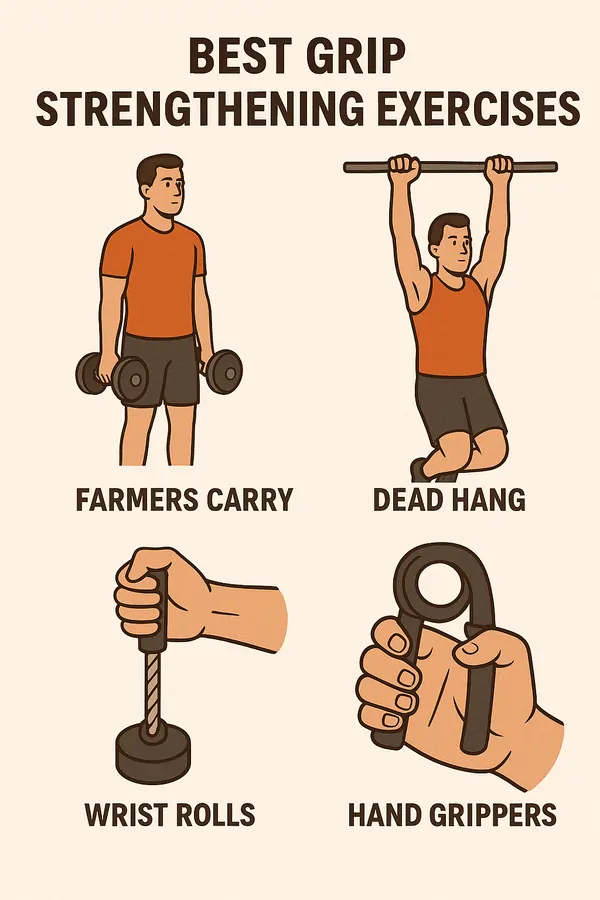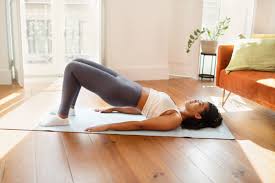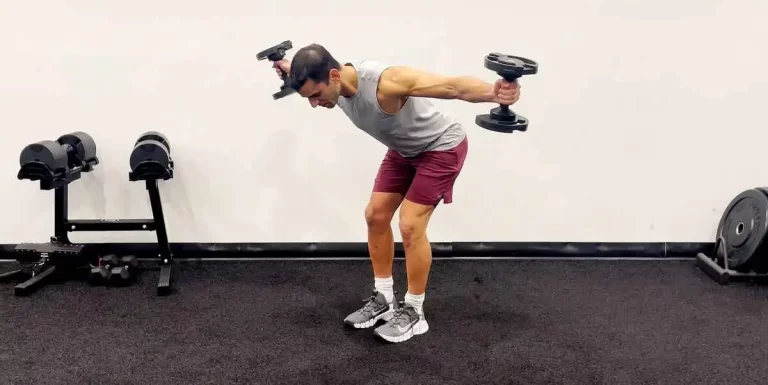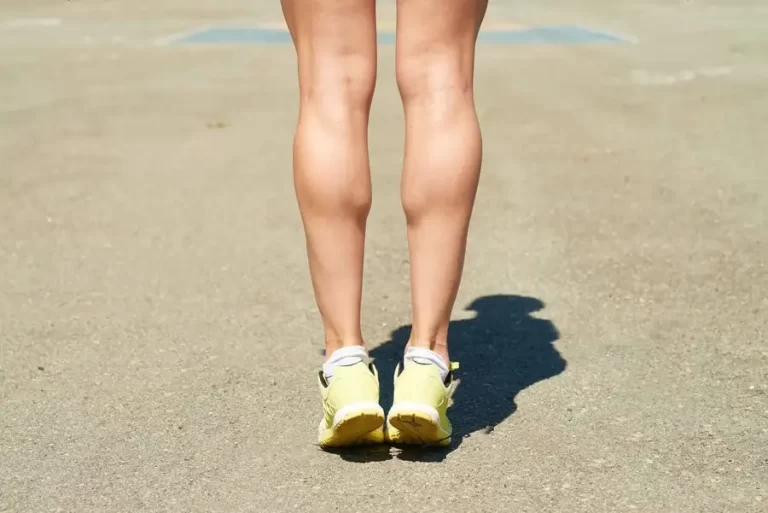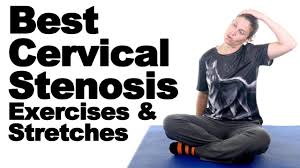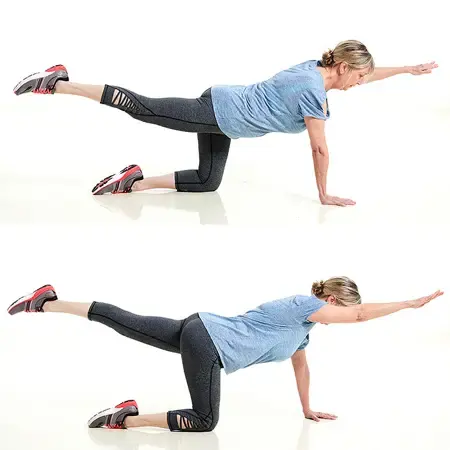15 Best Exercise for Bakers Cyst
Introduction
Exercise for Baker’s cyst can strengthen the muscles surrounding the knee joint, increase flexibility, and possibly lessen pain from Baker’s cysts. In addition to improving knee health, exercise can help manage the symptoms of Baker’s cysts. However, it’s essential to approach exercise cautiously and under a doctor’s supervision.
Even while exercise may not be able to heal Baker’s cysts at one time, focusing on thighs, hips, and lower leg muscles might help stabilize and support the knee joint. To reduce strain in the affected area, it may be possible to strengthen these muscles through improved joint alignment. It may also be helpful to perform stretches that gradually increase the knee joints and the surrounding muscles’ flexibility and mobility.
A Baker cyst is a swelling filled with fluid that develops on the back of the knee. The sensation of tension and swelling intensified as a result. There are situations where a popliteal cyst, also known as a Baker cyst, is the cause of calf pain. The pain could become severe when the knee is fully bent.
The disease known as Baker’s cysts occurs on the posteromedial side of the knee, between the semimembranosus tendon and the medial body of the gastrocnemius muscle. Adult patients may have arthrosis or meniscal abnormalities as a result of many conditions linked to intra-articular lesions.
Pain can be relieved and muscle weakening can be avoided with exercises that concentrate on preserving knee mobility. If you have a Baker cyst, get advice from your physician or physical therapist first. Frequent, mild exercise improves range of motion and builds up the knee-supporting muscles. Stretching activities can help improve muscle flexibility in this condition, which is primarily associated with stiff muscles. You can lessen some of the symptoms that may arise from Baker’s cyst illness by exercising for a few hours each week.
Types of Backers cyst:
- Primary Cyst: Nothing abnormal happens to the knee; the enlargement develops apart from the joint.
- Secondary Cyst: An enlargement of the bursa between the semimembranosus and gastrocnemius tendons, known as a secondary cyst, occurs when fluid leaks into the joint through the channel where the normal bursa normally fits. The most typical scenario is this one.
Causes:
- Gout
- Sprains.
- Osteoarthritis
- Anterior cruciate ligament injury
- Rheumatoid arthritis
- Bone fractures
- Knee damage experienced during sports
- Dislocations.
Signs and symptoms:
Symptoms consisted of;
- As much as you can bend your knee, you experience pain (producing a limited range of motion).
- Your knee joint may occasionally feel locked or clicked.
- Tightness in the knee’s back part
- Swelling in the calf muscle
- Usually feel a sudden, acute pain at the knee or in the back of your leg.
- Stiffness
- A sharp ache in the knee, Occasionally caused by an inflammation of the posterior leg or a sensation of water running down the calf
Risk factors:
Among the risk factors are:
- Overuse and injury: Both long-term overuse and injuries from accidents like falls or violent strikes can result in these cysts. A cartilage tear in the knee is typically a cause of them.
- Degenerative joint diseases: Rheumatoid arthritis and osteoarthritis patients may be at higher risk of developing these cysts.
Can an Exercise Help Correct a Baker’s Cyst?
One of the best therapies for a baker’s cyst is exercise. One of the main causes of popliteal or baker cysts is muscle tension. Popliteal cysts are aggravated by certain muscles, such as tight hamstrings (the muscles located in the back of your leg), which act as if you apply too much pressure to the cysts.
Exercises for knee mobility, such as heel slides, straight leg raises, bridge exercises, etc., can help with knee pain, edema, and inflammation that may be experienced during this condition. Cryotherapy, which involves ice packs, cubs, and massages, is another method for reducing swelling. After working out, the swollen area can be treated with cryotherapy.
Seeing a physical therapist who can thoroughly evaluate you is a fantastic way to find out if your baker’s cyst knee pain is mostly caused by or worsened by muscular tightness. you can check using a specific test that reveals muscle tension for certain specific muscles, such as the hamstring and calf muscles. You can stretch the targeted muscles regularly to relieve muscle tension.
Exercise for Bakers Cysts:
Exercise therapy is a set of targeted exercises intended to increase the knee’s strength, flexibility, and range of motion.
Heel slide
- Maintain straight legs while sleeping on your back.
- Carefully bring one heel back toward the buttock while bending at the knee.
- Hold this position for a few seconds.
- Stretch your heel slowly in the other direction while maintaining a straight leg.
- Then return to your neutral position.
- Then relax.
- Repeat this exercise five to ten times.
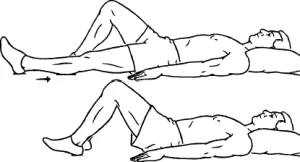
Hamstring stretch
- Pay attention to your posture as you sit on a table, yoga mat, or bed.
- With your toes free, place your heel on the ground and position the leg you wish to stretch straight upward.
- Maintain a flat back while putting more weight forward at the hips.
- Until your lower leg starts to stretch, keep extending your trunk forward.
- Hold this position for a few seconds.
- Then return to your neutral position.
- Then relax.
- Repeat this exercise five to ten times.
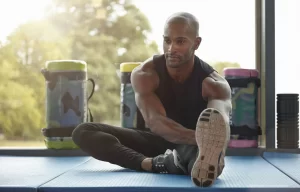
Calf stretch
- Start with a standing position on the facing wall.
- Throughout the workout, be sure to maintain a straight posture.
- Step forward after putting the leg that must be stretched behind you.
- Keep your knee straight on the leg you are extending, and continue forward until you feel pressure in your calf or knee.
- Hold this position for a few seconds.
- Then return to your neutral position.
- Then relax.
- Repeat this exercise five to ten times.
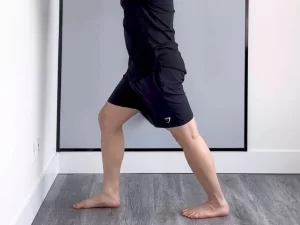
Seated hamstring stretch
- Seated at the edge of a chair, place your heel on the floor and extend one leg out in front of you.
- Bend at the hips as you lower your body to the ground.
- Hold this position for a few seconds.
- Then return to your neutral position.
- Then relax.
- Repeat this exercise five to ten times.
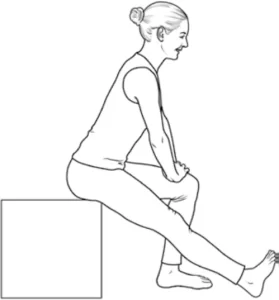
Straight leg raise
- On a comfortable spot on the floor, lie down on your back.
- Bend one leg to a ninety-degree angle while maintaining a firm foot placement on the ground.
- Verify that your opposite leg is straight.
- Your quadriceps should be used to lift your straight leg off the ground and provide better support.
- Hold this position for a few seconds.
- After letting out a breath, slowly return your leg to the ground.
- Then return to your neutral position.
- Then relax.
- Repeat this exercise five to ten times.
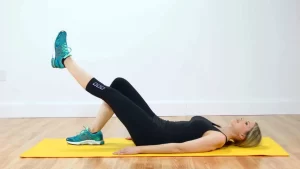
Heel raise
- Choose a comfortable standing position first.
- Hold onto the back of the chair to keep your balance.
- To maintain your position on your heels, raise them off the ground.
- Hold this position for a few seconds.
- Put your heels down after that.
- Then return to your neutral position.
- Then relax.
- Repeat this exercise five to ten times.
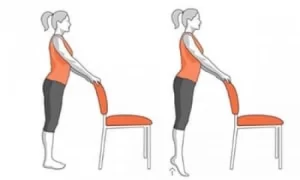
Bridge
- Bend both knees and plant both feet flat on the floor while lying flat on your back.
- With the palms down, keep your arms by your sides.
- Elevate your back while progressively raising your pelvis.
- Maintain a grounded posture with your shoulders and upper body.
- Hold this position for a few seconds.
- Beginning at the top of the spine, slowly lower the pelvis and return toward the ground.
- When the back is completely flat against the floor once more, lower yourself into the spine.
- Then return to your neutral position.
- Then relax.
- Repeat this exercise five to ten times.
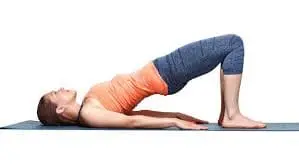
Bridge March
- Start on the floor in a comfortable, reclining position.
- Press your heels into the floor and raise your pelvis until your shoulders, pelvis, and knees make a straight line.
- Keep the bridge position for an additional time when your right knee comes to rest against your chest and your hips are at a ninety-degree angle.
- Place the heel back on the ground and raise your left knee.
- Take care to prevent your back from arching or your pelvis from sagging while you elevate and lower your knees.
- Then return to your neutral position.
- Then relax.
- Repeat this exercise five to ten times.
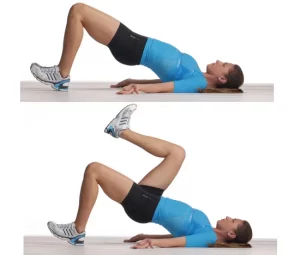
Single-Leg Glute Bridge
- Keeping your feet flat on the floor, knees flexed, and hands by your sides, lay on your back.
- Raise one foot and completely extend the leg so that it is at a 45-degree angle to the ground.
- Once your shoulders and knees are in a straight line, raise your hips while contracting your abs and buttocks to help with the lift.
- Similarly contract your core, as though attempting to draw your belly button closer to your spine.
- Hold this position for a few seconds.
- Return to the starting posture by lowering the hips to the floor gradually and mindfully while maintaining an outstretched leg.
- Then relax.
- Repeat this exercise five to ten times.
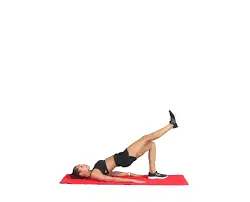
Bridge Exercise with resistance band
- Choose a resistance band whose strength is suitable for your current level of fitness.
- Position yourself on the floor so that your knees are at a right angle and your back is parallel to the floor.
- Wrap the resistance band around each thigh so that it sits slightly above the knees.
- Lift your hips toward the sky, keep your arms by your sides, and press your knees out against the bands.
- Your muscles should be tight.
- Let go of the pressure after a few seconds of holding the position.
- Then return to your neutral position.
- Then relax.
- Repeat this exercise five to ten times.
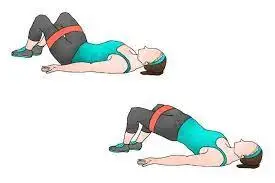
Clamshell
- You begin by lying on your side.
- Bend your elbow while lying on your left side.
- Next, raise the support to your head with your left hand.
- Place your right foot and leg atop your left, then bend your knees to a 45-degree angle.
- For balance, place your right hand lightly on the ground in front of you or on your hip.
- Next, lift your right knee softly toward the sky while keeping your feet close to your upper body.
- Hold this position for a few seconds.
- Reposition your lower right leg to meet your left, keeping your core firm.
- Then return to your neutral position.
- Then relax.
- Repeat this exercise five to ten times.
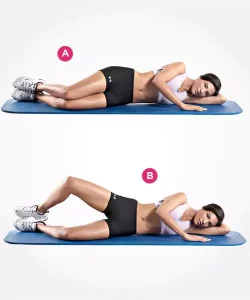
Resistance Clamshell
- Spread your legs widely apart while lying on your side.
- Place your forearm on the mat.
- Next, place a resistance band around both of your two thighs.
- With your feet together and your knees and hips positioned properly, turn your knees to a 45-degree angle.
- Place your head on your palm for additional support while you extend another hand out toward you on the floor.
- The abdominal muscles is activated when you contract your abs and compress your lower abdomen toward your spine.
- Keeping your lower leg flat on the mat, carefully elevate your upper knee to its highest point.
- Hold this position for a few seconds.
- Then return to your neutral position.
- Then relax.
- Repeat this exercise five to ten times.
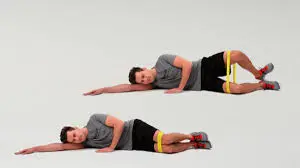
Lateral sidewalk
- Once the band has been wrapped around both legs, a little above each knee, it should be flat rather than twisted.
- Make sure the space between your feet is the same width as your shoulder.
- The band should be tight but not overly stretched.
- Your gluteus medius will contract as you take a half-squat and bend your knees slightly.
- Maintain a proper distribution of your body weight and both of your feet parallel to your shoulders while you look forward.
- Holding your half-squat, shift your weight over one leg and sideways with the other.
- Five to ten sideways in and out motions with this leg are recommended.
- Maintain a level hip throughout the exercise.
- It’s beneficial to maintain a low, forward-facing posture when performing this exercise.
- Gradually adjust your legs and weight.
- Then return to your neutral position.
- Then relax.
- Repeat this exercise five to ten times.
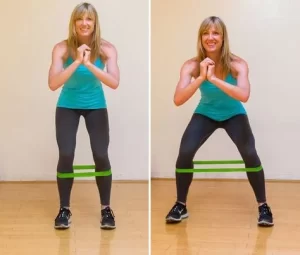
Wall squat
- The initial point is to stand near the wall.
- Keep your feet planted on the ground.
- Back up against a wall, if possible.
- Make sure your shoulder length is equal to the distance between your feet.
- Slowly bend your knees while maintaining your back and pelvis on the wall.
- Refrain from pushing yourself too far.
- Hold this position for a few seconds.
- Then return to your neutral position.
- Then relax.
- Repeat this exercise five to ten times.
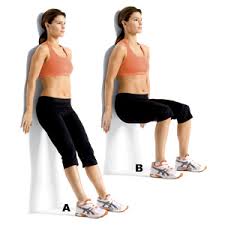
Walking
- Sometimes, injuries to the knee led to the development of Baker’s cysts.
- Walking for extended periods while recovering from surgery is beneficial in the progressive restoration of muscle strength, flexibility, and mobility.
- It might not be safe to walk at that specific moment, though, if a person needs to adjust their gait (pattern of walking) or bend their knee into an odd posture to walk comfortably.
- If your doctor or physical therapist says you can walk, you should do so.
- If not, you can begin by taking steps and work your way up to regular walking.
- It is possible to walk for one to three circuits.
- Increase the number of rounds progressively.
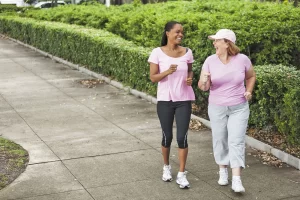
What safety measures are necessary when working out?
- Try not to move too quickly or forcefully when working out.
- Avoid doing challenging activities.
- Make modest bending and stretching movements.
- Ensure that the equipment you utilize is securely set.
- When you exercise, take care of yourself and remain aware to prevent falling.
- To help improve your range of motion and encourage relaxation throughout your workout, wear loose, comfortable clothing. Stay away from extremely tight or fashionable clothes.
- Take a break in between your exercise sessions.
- Keep your posture straight when exercising.
- It’s normal to stretch the muscles in your tight joints, although it might be challenging at times. Stretching and exercise are bad for you and aggravate your condition; therefore they shouldn’t hurt or make you feel like someone is stabbing you.
- Before and after sets, as well as for the recommended number of repetitions for each exercise, stretches should be done in line with the protocol.
- Remain hydrated.
- Exercise should be stopped as soon as the pain gets severe.
When are you going to stop working out?
- Fever
- Exercise should be stopped if it hurts.
- Severe burning in the muscles.
- Headache
- You don’t feel good.
- If numbness or pain are present.
Prevention:
It is common for a Baker’s cyst to develop after a knee injury. Therefore, the best defense against the development of these cysts is to avoid knee injuries.
To prevent knee injuries:
- Put on comfortable, supportive shoes.
- For sports and exercise, warm up beforehand and cool down afterward.
- If your knee is already sore and tender, don’t exercise on it.
- Treatment for any injuries to the knee, leg, or foot is necessary; skipping this step could result in falls and other issues.
Summary:
A fluid-filled bump that appears on the back of your knee is called a Baker cyst. It commonly happens following an injury or if your knee joint becomes swollen for some reason. Although Baker’s cysts aren’t typically a dangerous condition, you should always have a physical therapist look at and diagnose any new growths or developments in your body.
Sometimes a Baker cyst can be treated on its own, and pain is not always caused by it. To be sure it’s not a symptom of something more serious, it’s crucial to have the problem assessed by your physical therapist.
Maintaining the range of motion in the knee through exercise may help reduce pain and avoid muscular weakening. However, see a physician or physical therapist first before beginning any exercise program for a Baker’s cyst. Exercises done incorrectly could aggravate the knee and cause harm.
FAQ:
What is the duration required for the healing of a Baker’s cyst?
You should have planned for a ride home as you won’t be able to operate a vehicle during your rehabilitation. After the surgical removal of the baker’s cyst, the wound usually takes four weeks to heal fully.
Which exercises are best avoided if you have Baker’s cyst?
Certain actions made the movement worse. avoid any form of repetitive tension or unpleasant movement if possible. Even certain typical activities with repetitive movements if done constantly over a while will create irritation. Exercise-related irritation or other recurrent stress can lead to a persistent Baker’s cyst and the potential growth of fibrous scar tissue.
Is it safe to walk with a Baker’s cyst?
Knee injuries are frequently the cause of Baker’s cysts. Walking may help in the gradual regaining of strength and mobility during the healing process. Walkability may still be compromised if an individual needs to modify their gait or oddly flex their knee to walk comfortably.
Is Baker’s cyst better treated with physical therapy?
A crucial part of treating Baker’s cyst is physical therapy. Fluid swelling can be managed with the help of manual therapy, such as soft tissue therapy. To decrease strain and regain range of motion, this is extremely crucial. Regaining joint mobility, maintaining muscular flexibility, and preserving the strength of the muscles that support the hip and knee joints are the primary objectives of physical therapy.
Do Baker’s body cysts continue to grow?
A Baker’s cyst usually only produces mild symptoms, but problems might occur, such as the cyst getting bigger and making your symptoms worse.
For Baker’s cyst, is cold or heat more beneficial?
If a baker’s cyst is the diagnosis for you, there are a few strategies to lessen your pain and irritation: As long as there is pain and swelling twice or three times a day. Taking a warm bath or using a heating pad once a day can help in reducing swelling.
Do Baker’s cysts cause harm?
Although a Baker cyst is not harmful in the long run, it can be uncomfortable and bothersome. Baker’s cyst symptoms frequently come and go. Chronic disability is not common.
What is the primary reason behind Baker’s cyst?
An arthritis or a tear in the cartilage of the knee joint is the most frequent cause of Baker cysts. The knee may produce too much fluid as a result of this illness. Despite the potential for pain and swelling, treating the underlying problem causing the Baker cyst typically produces relief.
References:
- D. Prajapati (2023d, 8 August). The Top 16 Bakers Cyst Exercises – Samarpan Physiotherapy. Physiotherapy Clinic in Samarpan. The 16 best exercises for baker’s cysts are available at the Saramarpan Physio Clinic.
- June 24, Villines, Z. (2024a). Baker’s cyst exercises and self-care. Exercises: https://www.medicalnewstoday.com/articles/327497
- 2018 June 18; Lindberg, S. 5 Tasks to Help With Baker’s Cyst Treatment. We line. Here are some exercises for the baker’s cyst on Healthline.com.
- Physio, S. (1985a–1985c). The top five Exercises for a Baker’s cyst are recommended by a Surrey physiotherapist. Surrey Physical Therapy. The top five exercises for a baker’s cyst can be found at https://www.surreyphysio.co.uk.

